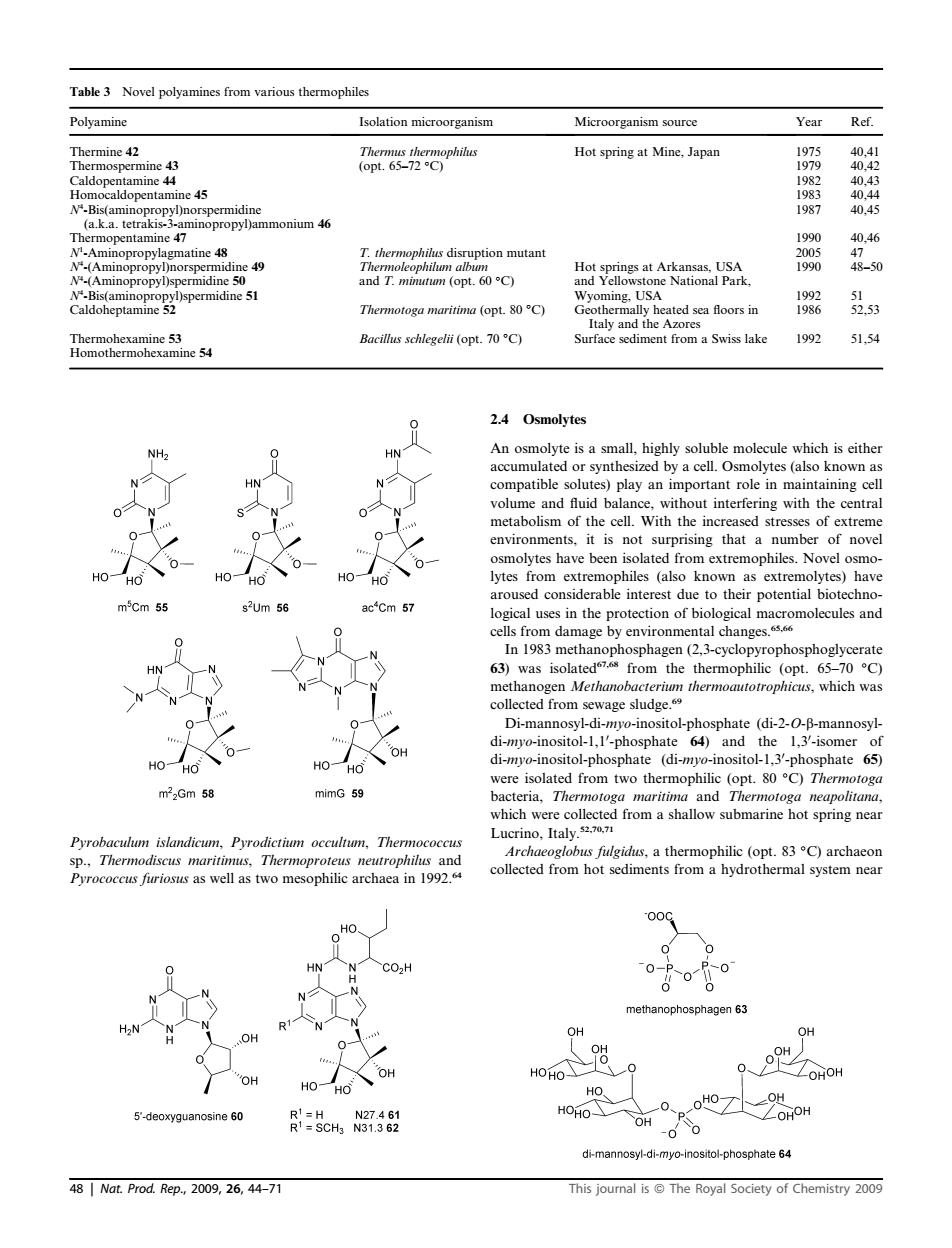正在加载图片...

Table3 Novel polyamines from various thermophile Polyamine Year Ref. Thermine 42 6 Hot spring at Mine.Japan >45 k a te ine 47 opropylagmatine4 .mutant and T.(opt 60C) Thermotoga maritima (opt.8C) andteatedsaioorsin 1 s Hocmombeote53ne4 Bacillus (opt.70C) Surface sediment froma Swiss lake 1992 51,54 2.4 Osmolyte An osmolyte is a small.highly soluble molecule which is either tes)play an importan ng c the c.With the trem n it is not surprising that a numb of nove H aroused considerable interest due to their potential biotechno 2 acCm 57 In 1983 methanophosphagen (2,3-cyclop rophosphoglycerate from the thermophilic (opt.65-70C) DnahdnoioLphosphate(di2.O,B-man0ryl 1.3'-isomer HO- m2Gm 58 mimG 59 bacteria,Thermotoga maritima and Thermotoga neapolitan a shallow submarine hot spring nea isus as well as two mesophilic archaea in and collected from hot sediments from a hydrothermal system near 00 0-P 日0 OH OH Ho义 OHOH OH 5'-deoxyguanosine 60 R:50h375副 di-mannosyl-di-myo-nositphosphate6 48|Nat.Prod.Rep,2009,26,44-71 This journal isThe Royal Society of Chemistry009 Pyrobaculum islandicum, Pyrodictium occultum, Thermococcus sp., Thermodiscus maritimus, Thermoproteus neutrophilus and Pyrococcus furiosus as well as two mesophilic archaea in 1992.64 2.4 Osmolytes An osmolyte is a small, highly soluble molecule which is either accumulated or synthesized by a cell. Osmolytes (also known as compatible solutes) play an important role in maintaining cell volume and fluid balance, without interfering with the central metabolism of the cell. With the increased stresses of extreme environments, it is not surprising that a number of novel osmolytes have been isolated from extremophiles. Novel osmolytes from extremophiles (also known as extremolytes) have aroused considerable interest due to their potential biotechnological uses in the protection of biological macromolecules and cells from damage by environmental changes.65,66 In 1983 methanophosphagen (2,3-cyclopyrophosphoglycerate 63) was isolated67,68 from the thermophilic (opt. 65–70 C) methanogen Methanobacterium thermoautotrophicus, which was collected from sewage sludge.69 Di-mannosyl-di-myo-inositol-phosphate (di-2-O-b-mannosyldi-myo-inositol-1,10 -phosphate 64) and the 1,30 -isomer of di-myo-inositol-phosphate (di-myo-inositol-1,30 -phosphate 65) were isolated from two thermophilic (opt. 80 C) Thermotoga bacteria, Thermotoga maritima and Thermotoga neapolitana, which were collected from a shallow submarine hot spring near Lucrino, Italy.52,70,71 Archaeoglobus fulgidus, a thermophilic (opt. 83 C) archaeon collected from hot sediments from a hydrothermal system near Table 3 Novel polyamines from various thermophiles Polyamine Isolation microorganism Microorganism source Year Ref. Thermine 42 Thermus thermophilus (opt. 65–72 C) Hot spring at Mine, Japan 1975 40,41 Thermospermine 43 1979 40,42 Caldopentamine 44 1982 40,43 Homocaldopentamine 45 1983 40,44 N4 -Bis(aminopropyl)norspermidine (a.k.a. tetrakis-3-aminopropyl)ammonium 46 1987 40,45 Thermopentamine 47 1990 40,46 N1 -Aminopropylagmatine 48 T. thermophilus disruption mutant 2005 47 N4 -(Aminopropyl)norspermidine 49 Thermoleophilum album and T. minutum (opt. 60 C) Hot springs at Arkansas, USA and Yellowstone National Park, Wyoming, USA 1990 48–50 N4 -(Aminopropyl)spermidine 50 N4 -Bis(aminopropyl)spermidine 51 1992 51 Caldoheptamine 52 Thermotoga maritima (opt. 80 C) Geothermally heated sea floors in Italy and the Azores 1986 52,53 Thermohexamine 53 Bacillus schlegelii (opt. 70 C) Surface sediment from a Swiss lake 1992 51,54 Homothermohexamine 54 48 | Nat. Prod. Rep., 2009, 26, 44–71 This journal is ª The Royal Society of Chemistry 2009